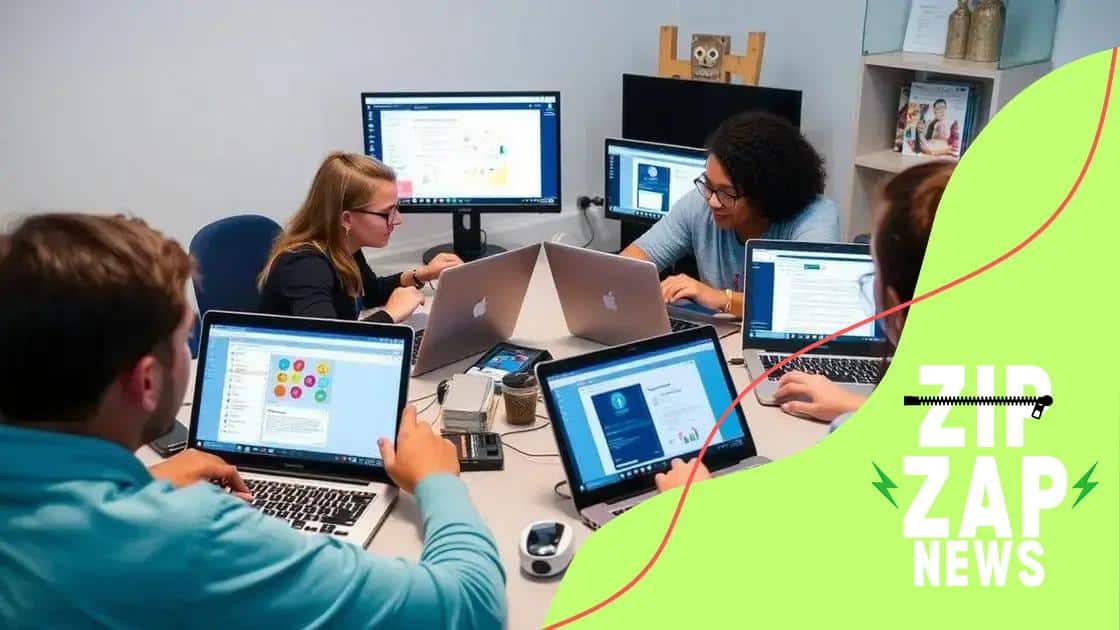Collaborative learning through online platforms: revolutionizing education

Collaborative learning through online platforms enhances student engagement and teamwork while addressing challenges like communication barriers and technical difficulties, utilizing technology for more effective educational experiences.
Collaborative learning through online platforms is changing how we engage with education. Have you ever wondered how group projects can transcend physical barriers? Let’s dive into this transformative approach.
Understanding collaborative learning
Understanding collaborative learning is essential for harnessing the power of group dynamics in education. This method emphasizes the role of social interaction and shared responsibility among learners.
In collaborative learning, students work together to achieve a common goal. The idea is that by engaging with peers, they can learn from each other, share knowledge, and cultivate critical thinking skills. This approach helps create a supportive learning environment where everyone feels valued.
Key Principles of Collaborative Learning
There are several key principles that make collaborative learning effective:
- Active participation: All members should engage actively, sharing perspectives and insights.
- Common goals: The group should work towards achieving a shared objective.
- Accountability: Each member is responsible for their contributions to the group.
- Respect and trust: A safe environment is created where students can express their thoughts freely.
Another significant aspect of collaborative learning is its adaptability to various online platforms. These tools allow students to communicate, collaborate, and access resources from anywhere in the world. As more learners embrace digital education, the importance of these platforms grows. They offer features like chat rooms, video conferencing, and document sharing, which facilitate collaboration beyond traditional classroom walls.
By using online platforms effectively, students can experience diverse learning styles, encouraging them to think critically and work collaboratively. This dynamic fosters relationships that can enhance their overall educational experience.
The success of collaborative learning relies on understanding group dynamics and leveraging technology. As students interact, they learn to navigate different perspectives and develop empathy, skills that are crucial in and out of the classroom.
In essence, embracing collaborative learning not only enriches educational experiences but also prepares students for teamwork in their future careers.
Benefits of online platforms for learning
The benefits of online platforms for learning are numerous and impactful. They provide unique opportunities that traditional classrooms may not offer. One significant advantage is flexibility. Students can learn at their own pace and schedule, allowing for a more personalized education experience.
Another key benefit is access to resources. Online platforms often come equipped with a variety of tools and materials that enhance learning. These can include videos, articles, and forums where students can ask questions and engage with others.
Enhanced Collaboration
Online platforms also promote collaboration. Students can work together on projects and share ideas easily, regardless of their location. This feature fosters teamwork and communication skills vital for the modern workforce.
- Global Reach: Connect with students and experts from around the world.
- Diverse Learning Materials: Access various formats like videos, podcasts, and interactive quizzes.
- Real-Time Feedback: Get instant input on assignments and discussions.
- Engagement: Use multimedia elements to make learning more interesting.
Additionally, online platforms often include features like progress tracking and analytics. These tools enable learners to set goals and monitor their development over time. Such capabilities empower students by providing them insight into their learning journey.
Finally, the social aspect shouldn’t be overlooked. Online communities encourage students to interact, share experiences, and create support networks. This can significantly boost motivation and engagement, as learners feel connected to a larger group.
Embracing online platforms for learning not only enhances educational opportunities but also prepares students for the increasingly digital world.
Effective strategies for collaboration online

Effective strategies for collaboration online are crucial for successful group work in virtual environments. Students can achieve great results when they implement practical approaches to teamwork. First, establishing clear communication channels is vital. Using tools like chat applications and video conferencing ensures that everyone stays connected and informed.
Creating a structured plan for tasks can also enhance team productivity. By assigning roles and setting deadlines, team members know what is expected. This clarity helps avoid confusion and overlaps in responsibilities.
Tools for Collaboration
Incorporating specific online tools can streamline processes and facilitate seamless collaboration. Here are some valuable tools:
- Project Management Software: Tools like Trello or Asana help track tasks and progress.
- Document Sharing: Google Drive or Dropbox allows multiple users to edit files simultaneously.
- Video Conferencing: Platforms like Zoom enable face-to-face communication even when apart.
- Feedback Systems: Using platforms that allow peer reviews can boost collaborative learning.
Moreover, establishing ground rules is essential for effective online collaboration. These guidelines can cover aspects like response times, meeting etiquette, and conflict resolution. Having these rules in place helps create a respectful and professional work environment.
Encouraging participation from all group members is another key strategy. This can be achieved by actively soliciting input from quieter members and ensuring that everyone has a chance to contribute. Using techniques such as brainstorming sessions can help to generate creative ideas and foster inclusivity.
Finally, it’s important to reflect on the group’s collaboration process after completing a project. Discussing what worked well and what can be improved will help teams refine their strategies in future collaborations.
Challenges in online collaborative learning
Challenges in online collaborative learning can affect the overall experience and outcomes for students. While this approach offers many benefits, there are notable obstacles that learners and educators must navigate. One significant challenge is the issue of communication barriers. In an online setting, misunderstandings can occur more easily due to lack of non-verbal cues, leading to potential conflict.
Another challenge is the unequal participation among group members. Some students may dominate discussions while others remain silent, which can hinder collaboration. It’s essential for groups to create an environment where everyone feels comfortable sharing their ideas.
Technical Difficulties
Technical issues frequently arise, potentially disrupting the learning process. Connectivity problems can prevent students from joining meetings or accessing resources. It’s important to have contingency plans in place to address these problems swiftly, ensuring that learning continues smoothly.
- Inconsistent Access: Not all students may have reliable internet or devices.
- Learning Platforms: Some users may find tools complex or difficult to navigate.
- Time Zone Differences: Scheduling meetings can be tricky for groups spread across different locations.
- Resource Availability: Limited access to academic materials can impact engagement.
Moreover, without the physical presence of peers, students might struggle with feelings of isolation. The lack of face-to-face interaction can lead to decreased motivation. To combat this, forming smaller study groups or implementing regular check-ins can help maintain a sense of community.
It is also crucial to promote self-management skills. Online collaborative learning often requires students to monitor their time effectively and stay organized. Without proper skills in these areas, some may struggle to keep up with tasks and deadlines.
Lastly, educators must continuously adapt their teaching strategies to address these challenges. Providing training on collaboration tools and fostering a culture of feedback can help improve the online collaboration experience for everyone involved.
Future trends in collaborative educational platforms
The future trends in collaborative educational platforms are shaping the way we approach learning and teamwork in digital environments. As technology evolves, new features and methodologies are emerging that enhance the collaborative experience for students around the world. One significant trend is the rise of artificial intelligence in education. AI tools can provide personalized learning experiences, adapting content and assessments to meet individual student needs.
Another trend is the increased focus on gamification. Many platforms are integrating game-like elements to make learning more engaging. This approach not only boosts motivation but also encourages friendly competition among peers, promoting teamwork.
Integration of Virtual Reality (VR)
The integration of virtual reality (VR) and augmented reality (AR) is also becoming more common. These technologies create immersive learning environments where students can collaborate in real-time, regardless of their physical location. For instance, students can explore historical sites or conduct virtual science experiments together, which enhances their understanding and retention of complex concepts.
- Enhanced User Experience: Future platforms will prioritize user-friendly interfaces and accessibility for all users.
- Cross-Platform Compatibility: Seamless integration among different devices will enable collaboration anytime, anywhere.
- Data Analytics: Educators will utilize data to track student progress and tailor learning experiences more effectively.
- Social Learning: Emphasis on community-building features will foster stronger connections among students and teachers.
Another important trend is the increasing emphasis on social emotional learning (SEL). Collaborative platforms are incorporating resources that promote empathy, communication, and relationship skills. By nurturing these skills, students are better equipped to work together effectively.
Finally, as the demand for flexible learning options grows, we may see more hybrid models of education. These platforms will combine both synchronous and asynchronous learning opportunities, allowing students to collaborate in ways that suit their schedules and preferences.
FAQ – Frequently Asked Questions about Collaborative Learning Online
What are the main benefits of online collaborative learning?
Online collaborative learning enhances engagement, allows for diverse perspectives, and develops important skills like teamwork and communication.
What challenges can students face in online collaboration?
Students may encounter communication barriers, unequal participation, and technical difficulties that can hinder effective collaboration.
How can technology improve collaborative learning experiences?
Technology like AI, gamification, and VR can create more engaging, personalized, and interactive learning environments.
What strategies can promote effective online collaboration?
Establishing clear communication channels, using project management tools, and encouraging equal participation among group members are vital strategies.





